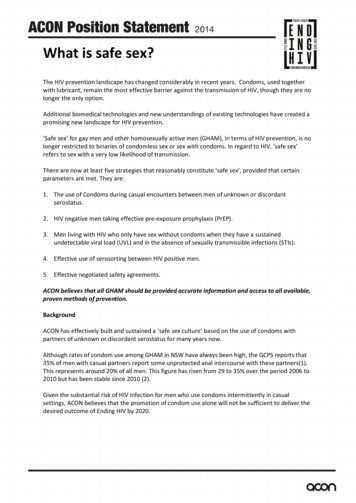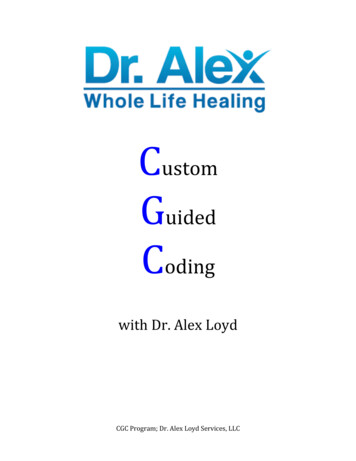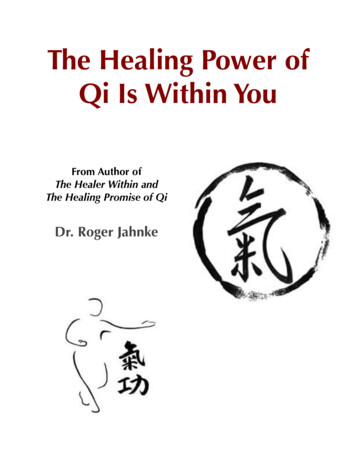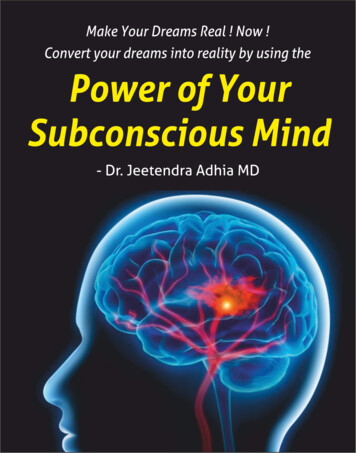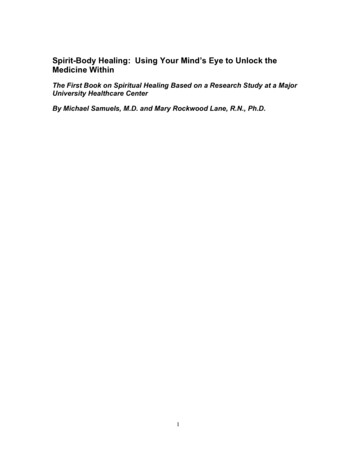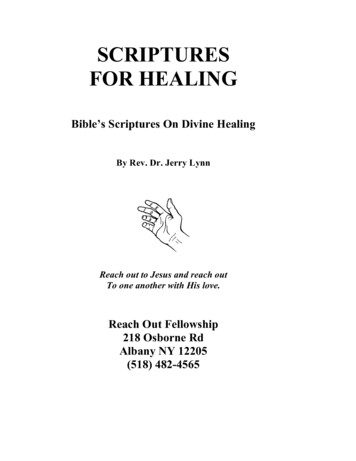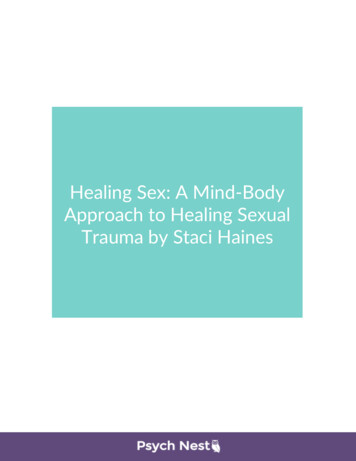
Transcription
Healing Sex: A Mind-BodyApproach to Healing SexualTrauma by Staci Haines
Disclaimer:The information contained in this guide or distributed by PsychNest.org is for general informationpurposes only. Throughout this Disclaimer the words “PsychNest.org,” “we,” and “I,” refer toPsychNest.org as a company, and as a service. The information is provided by PsychNest.org and whilewe endeavor to keep the information up to date and correct, we make no representations or warranties ofany kind, express or implied, about the completeness, accuracy, reliability, suitability or availability withrespect to the website or the information, products, services, or related graphics contained on the websitefor any purpose. Any reliance you place on such information is therefore strictly at your own risk.Information provided on the PsychNest.org website or information provided by PsychNest.org employeesor representatives should not be treated as expert advice in any particular field.We take consideration in making the language we use original and unique. Every summary has a link toobtain the original book. We always recommend the original works as they offer more in depth examples,explanations, and references. Our goal is to give you a snapshot in our own interpretations and never theentirety of the book.Should you have any questions regarding this disclaimer, please contact us at support@psychnest.org
Healing Sex: A Mind-Body Approach to Healing Sexual Trauma by Staci HainesLiving past childhood sex abuse leaves scars that are difficult to heal. Among these, one of theleast discussed is the scar it leaves on the victims’ sexual nature. Many survivors feel that theydo not need to heal sexually because they have developed problematic attitudes towards theirbodies and physical intimacy.However, sexuality is a vital part of human nature. To be able to fully understand, enjoy andcome to terms with one’s own sexual desires is a powerful way for survivors to take back a partof themselves that has been exploited and abused. They must learn to forgive themselves andunderstand that they—and their bodies—are not at fault for the abuse that happened in theirchildhood. The effects of the trauma as they grow older can be unlearned and lead to a happier,more fulfilled life.The first step to sexual healing is to find a reason to do it at all. To be able to undergo thedifficult process of sexual healing, survivors should actually want to do it. Talk through thebenefits of undergoing the process.Making survivors feel safe opens them up to sexual healingSafety and sexual activity are mutually exclusive concepts to most survivors of childhood sexualabuse. As such, this is one of the first obstacles to overcome in the road to sexual healing—survivors can’t explore their sexual nature if they don’t feel safe.First, help survivors learn to assess their external safety. This refers to the actual physicalsituation they are in. The next step is to help them achieve internal safety or the feeling of beingat ease. Many survivors of childhood sexual trauma can never fully relax even if they know theyare physically safe—this hinders healing. They must learn to build a sense of internal safety tofully explore their sexual expression.To create a sense of internal safety, you can:1. Help them identify which parts of their body are physically tense. It could be a tightening ofthe stomach, stiffness in the chest or ringing in the head.2. Help them identify which parts of their body they feel security and draw strength from.3. If this is difficult, help them think happy thoughts—things that give a sense of comfort, orbring a smile to their face. It could be a person they love, an activity they like to do, or aplace they want to be. These are the building blocks of internal well-being.4. Help them recognize the physical sensations associated with these building blocks. It couldbe a spreading of warmth in the chest, or a relaxation of the body parts that were tensebefore. These are called resourceful sensations.Isolation can be cured through self-care and community support
Children who are sexually abused often feel isolated and unable to share their experiences,thoughts and feelings. However, sexual healing requires a support system, both withinthemselves and with others.Self-care is about being kind to oneself and taking actions to ensure one’s personal needs andwants are met—physically, emotionally, mentally, and sexually. Physically, this means eatingright, sleeping enough, exercising and engaging in hobbies and activities that bring happiness.Breathing properly is an aspect of physical self-care that often goes unnoticed. Make sure thatthe diaphragm and chest move when inhaling and exhaling.Teach survivors to use kind and comforting words when talking to themselves. Encourage themto congratulate themselves for steps they are taking in their sexual healing, whether big or small.Emphasize the importance of solitude or taking time to think and be alone. Support inclinationstowards spirituality, especially meditation and self-awareness exercises. Survivors may havedeveloped addictions to harmful substances and practices, and these must be dealt with as well.Equally important as self-care is community support. Having other people who love, accept andencourage survivors through the process of sexual healing is essential to recovery. These can befamily members, friends, or fellow survivors. Engaging a therapist who has had formal trainingin human sexuality, is sex-positive, knowledgeable about safe sex practices and is clear aboutboundaries with clients can also serve as valuable support.Sexual healing is best addressed through somatics and embodiment exercisesThe study of somatics focus on the connection between the body, mind and emotions ascomponents of one biological system. Since the body was harmed during abuse, then a somaticapproach is particularly powerful in repairing the damage both inside and out.One focus of sexual healing is “embodiment” or being actively conscious of one’s body and itsreactions. Using body-based techniques can be highly effective in removing triggers andprocessing abuse. To help survivors, you can use resources from Rubenfeld Synergy, SomaticExperiencing and the Strozzi Institute. Other exercises include dancing, martial arts andmeditational practices centered around the body.Practicing safe sex increases the feeling of safety and security when exploring sexualitySafe sex practices aim to prevent the transmission of bodily fluids between sexual partners toprevent sexually transmitted diseases (STDs) and/or pregnancy.A commonly used safe sex practice is the use of physical barriers like condoms, latex gloves andplastic food wrap. The use of lubrication can help enhance sexual pleasure while using barriers.To remove any fear or awkwardness in using them, you may advise survivors to familiarizethemselves with the many options available by buying, playing and researching about them.Part of safe sex is assessing sexual risk of the partner and the sexual activity they want to engagein. Realistically speaking, there is no way to guarantee that a person is telling the truth about
their sexual history unless they provide medical results. Given this, it is best to have protectedsex with partners.Another factor to consider when assessing risk is the type of sexual activity—including whichbodily fluids are exchanged and how these are exchanged. It is advisable to research whichactivities have high, medium and low risk.Having regular check-ups with the obstetrician-gynecologist or urologist is essential in practicingsafe sex. If the survivor feels uncomfortable about this, advise them to go with a trusted andsupportive friend.ACKNOWLEDGING AND EXPLORING SEXUAL DESIREChildhood sexual abuse survivors may blame sexual desire for the cruelty they suffered. As such,they may have difficulty in accepting themselves as sexual beings. It is important to helpsurvivors see their sexual desires as a sign that they are able to hold on to who they are despitethe abuse. After having their sexual desires, wellbeing and safety ignored by their perpetrators,they are now finally in the position to define their sex lives according to what they want.Survivors may have difficulty in feeling sexual because of the abuse. The following embodimentexercises can help expel the shame, guilt or numbness they feel when expressing their sexuality:1. The Pelvic Rock. Have the survivor lie down with one’s back to the floor and knees bent.Move the hips up and down in a gentle thrusting motion. Have the survivor feel thesensations caused by the action for three minutes. Observe the emotional response to thisaction. Repeat with a faster pace.2. Genital Healing. Have the survivor lie down with one’s back to the floor and knees bent.Rub his/her palms together to generate heat. Then place one hand gently on the genitalarea. Have them imagine the heat travelling across their genitals to their pelvis, as ifthawing a frozen area. Do this for five minutes.Educating one’s self about sex helps dissect biases and perspectives that affect sexualexpressionWhat is considered “normal” sexual behavior is often very narrow and rigid, and hardlyencompasses many relationships, sexual activities, desires and fetishes experienced by people.Owning sexual desire means being able to explore and decide for themselves what sexualexpression they prefer. Survivors should reexamine what they know about sex and where theylearned about it, and see if that information is helpful in their sexual healing journey.Expanding what one knows about sexual expression through self-education helps people removefeelings of guilt and shame about what arouses them. This can be done through talking withtrusted friends about their own preferences, conducting research on accurate and sex-positivesites, and watching pornography.
MOVING PAST DISSOCIATIONSurvivors of childhood sexual abuse are adept at dissociation (also known as “checking out” or“spacing out” because it was the only way they could get through abusive encounters. This canby thinking of other, unrelated things during the abuse or erasing the memories or details of theabuse as time goes on. Dissociation translates to physiological responses like shallow breathingand muscle tension.Moving away from dissociation can be painful because it means remembering certain aspects ofthe abuse that were buried in an effort to preserve oneself. But healing fully meansacknowledging the pain, anger and betrayal head-on.To move from dissociation, survivors should learn to recognize what happens when they aredissociating, whether it is wandering thoughts or physiological signs.After being able to recognize the signs of one’s personal state of dissociation, the next step is tomove out from it. This can be done by being aware of what the body is feeling at the present,verbalizing emotions, thinking comforting thoughts to oneself in a positive and encouragingmanner, and rubbing parts that feel numb or alien.Encourage survivors to practice embodiment exercises regularly to help them stay within theirbodies—these can involve martial arts, dance, meditation or exercise. Have them spend 5-10minutes everyday sitting quietly and being aware of the sensations they feel, whether pleasurableor painful.UNLEARNING SELF-DENIALSurvivors of childhood sexual abuse are taught at a young age that their sexual desires, safetyand overall wellbeing are irrelevant. Because of this, they learn to deny themselves of pleasure.There are two reactions to this: sex aversion and sex compulsion. The former manifests throughthe desire to be completely asexual and deflect any sexual activity. The latter is the opposite,marked by an urge to use sex as the only way to interact with society.Sexual aversion stems from the idea that sexual desire caused the abuse, so they should avoid itat all costs. There is guilt and shame in exploring sexual desire, so they just sweep it under therug. Another manifestation is the ability to experience sexual intimacy, but not with theirromantic partners. The costs of sexual aversion include missing out on physical intimacy andforegoing valuable connections with others. More importantly, avoiding sex means avoidingacknowledging the anger and pain of sexual abuse, and in turn, avoiding full sexual healing.Recovering from sexual aversion means coming to terms with the specific reasons for avoidingsex, and slowly embracing it through self-education, embodiment and masturbation.Sexual compulsion is often confused for sexual expression. To distinguish the two, survivorsmust ask themselves why they engage frequently in sex. Is it because they find genuine pleasurefrom it, or because they need it to feel a sense of self-worth? Do they dissociate frequently
during sex? Do they just say “yes” all the time regardless of how they feel? The disadvantages ofsexual compulsion include the merging of self-esteem with sexual desire, and a higher risk ofSTDs.For those with sexual compulsion, the first step is to understand why they engage in sexfrequently and often indiscriminately. It may be a good idea to abstain from sexual activity. Butmake sure that the choice to be celibate is made in the interest of processing sexual healing ratherthan a way to avoid it.THE IMPORTANCE OF ACCURATE AND SEX-POSITIVE INFORMATIONSurvivors of childhood sexual abuse learn about sex without consent and with violence.Therefore, it is important re-educate oneself about sex through accurate and positive channels.A formal understanding of both the male and female genitalia, including where these are found,their general functions and how they can be used for one’s sexual gratification can help sexualhealing. Aside from genitalia, there are other parts of the body involved in sexual pleasure,including the pubococcygeus muscle (PC muscle), breasts and anus.Understandably, there may be parts of the human anatomy that are frightening because they stirmemories of the abuse. Survivors can read up on them or ask their partners to see them in a nonaroused state to normalize these body parts and begin to see them in a non-threatening manner.Understanding the physiological sexual response cycle leads to emotional healing andhealthy sexual expressionThe body undergoes biological changes when sexually aroused. For survivors of childhoodsexual abuse, it is important to emphasize that these physiological changes are natural andinvoluntary reactions of the body when stimulated sexually. This means it happens with orwithout consent. Even if they became wet, aroused or even came during the abuse is not a signthat they somehow wanted it to happen, or that their body betrayed them.Orgasms are of particular importance in attaining sexual pleasure. It is possible to learn how toinduce and intensify orgasms. Doing so through masturbation can be more comfortable for manypeople. Remember to breathe properly, encourage sex-positive self-talk and allow oneself to feelthe sensations.It is normal that learning how to orgasm can remind survivors of certain aspects of their abuse.Feeling these emotions and going through the memories can let loose the tension and trauma thathelps in the sexual healing process.Embracing the body relives the pain of abuse, but also frees held-up tensions andmisconceptions
An aversion to the body is an enduring effect of childhood sexual abuse. As such, they may havebody image problems, a nonchalant attitude to taking care of it, and a fear of truly engaging thebody in terms of sexual expression.To heal fully means unlearning the negative perception they once held and create a new, morepositive view. This process has multiple levels and can occur over a long period of time. Somaticpractices like yoga, martial arts, dance, sports and meditation can help bring awareness andappreciation for what the body can do. Deep reflection can help face the shame and guiltsurvivors feel towards their bodies and slowly ascribe those feelings to the perpetrators ratherthan themselves.MASTURBATION AND SELF-LOVEMasturbation has numerous physical and emotional benefits, allowing a person to understand thebody in a safe environment at his/her own pace. It is a powerful tool in sexual healing because itputs sexuality in the hands of the survivor, literally and figuratively.Masturbation also allows one to try sexual activities that otherwise would be uncomfortable orscary if done with a partner. Later on, sharing discoveries made by touching oneself can bringmore excitement in one’s sexual life.Despite all these, there are still reasons for people to not want to try masturbation. These may bereligious or cultural, or because masturbation was part of the abuse. If survivors don’t want to tryit, then that is fine. Sexual healing is all about consent. However, it is important to know if thechoice not to masturbate is their own, or if the abuse is making that choice for them.Touching oneself can lead to intense fear, anger and shame especially when survivors findthemselves masturbating to memories of their abuse. Allowing oneself to feel these emotionsagain and again through masturbation can increase tolerance for them.To get the most out of masturbation, survivors can relax by breathing and thinking positivethoughts, moving their bodies, being vocal through moaning and groaning, touching non-genitalparts of the body and practicing embodiment. Regular masturbation sessions where survivors cancreate an atmosphere conducive to arousal can be helpful.Though masturbation is usually thought of as a solitary activity, it can be done with a partnerwatching or partners pleasuring themselves in each other’s company.SEXUAL CONSENT AND BOUNDARIESConsent is being able to make a decision on one’s own terms and communicate those decisionsto other people. Sexually, this means being able to say “yes”, “no” or “maybe” to differentsensations and acts at any point during sexual activity.Survivors of childhood sexual abuse often confuse saying “no” with selfishness, leading toinstances of them having sex without actually wanting to. It is important for them to understand
that their sexual needs are just as important as that of their partner’s. Reincorporating consentand choice into the sexual lives of survivors is key to sexual healing.Survivors constantly make sexual decisions based on their heads alone, and completely ignoresignals from their bodies—these are vestiges of the abuse. Embodied consent means taking cuesfrom the body when it is okay to proceed with sexual activity.Verbalizing consent and boundaries creates a more fulfilled sex lifeOnce they are clear about what they want, the next step is to communicate these desires to theirpartners. Being open about sexual likes and dislikes, preferred safe sex practices and being clearabout what they want from the relationship may seem forward, but is actually a good way tominimize difficult situations later on. This should be a two-way conversation to negotiate thekind of sexual activity that is good for both parties—whether short-term or long-term partners.If survivors find that their partner does not agree to respect their needs, they can do any of threethings: (1) Mention the consequences of foregoing their needs, (2) Move to a neutralenvironment to release the tension, or (3) Leave.Emphasize to survivors that vocalizing both consent and dissent is not something to be ashamedof, and can be learned through practice and the right mindset.SEX WITH A PARTNERChildhood sexual abuse has conditioned survivors to expect the worst from their partners. Lateron, they tend to settle for people who give even just a little of what they want. This can lead tohaving sex when, where and with someone that they do not truly want.Adopting a self-referential form of sexual expression is key to having fulfilling sex with apartnerSurvivors should learn to recognize when having sex with a partner is good for them. If they areembodied and in the moment, feeling physically safe, relaxed and breathing deeply, are usingprotection, and have given informed consent to their partners, then they can proceed with havingsex.To be able to set standards for who they have sex with, survivors should know what they arelooking for in a sexual relationship. This should be communicated with prospective partners toavoid misunderstandings later on.Building trust can be difficult for survivors—they may find it difficult to trust, or may not beable to distinguish who they can trust. To be able to solve this, survivors can be taught to lookfor the following in their partners: (1) Competency or the ability to provide for their uniqueneeds, (2) Consistency in fulfilling promises, and (3) Congruence or ability to walk the talk.Talking about sex leads to a happier sexual relationship
Survivors should not be afraid to tell their partners what they want sexually, how they want itdone, what protection they want to use, and what their boundaries are. If they are comfortablewith discussing their history of sexual abuse with their partner, then talking about triggers andhow to deal with them should also be taken up. Talking about sex is best done before sex, in aneutral environment, using clear and sex-positive language. It is advisable to read up on how totalk about sex and practice verbalizing alone before talking to a partner.Gauging if, when, and how much to tell a sexual partner about their history of sexual abuse is thesurvivors’ choice. They should be reminded that a loving and supportive relationship can be agood place to heal. Shame has kept them in isolation, and they must learn that opening up topeople that they trust can be a powerful way to overcome that shame. There can be any numberof reactions to their disclosure depending on their partner’s history and background, and theyshould be prepared for that as well.ENJOYING SEXUAL EXPLORATION THROUGH PROCESSING TRIGGERSThrough sexual healing, childhood sexual abuse survivors should be able to see sex as apleasurable, funny, and expansive activity. Learning more about the various techniques can beboth fun and helpful in creating a more fulfilling sex life. Remind them that it’s not just aboutpenetrative sex—there are so many ways to pleasure one’s partner, from kissing to rimming andeverything in between. Penetrative sex can also mean using toys, fingers or whole hands, and caninvolve vaginal and anal. Encourage survivors to read up on the plethora of sexual activities,techniques and items to open their minds about what they can do.It is important to stress that having fun should also be done responsibly. Get rid of the notion thatsafe sex is not as pleasurable as unprotected sex—try using physical barriers, like latex condomsand gloves, coupled with lubricants in any sexual activity involving bodily fluids. Encouragesurvivors to research on what form of protection is most appropriate for their sexual activity ofchoice.Dealing with triggers is a necessary part of sexual healingA trigger is anything that brings back memories of abuse that usually causes a survivor to shutdown or react negatively. Most survivors try to avoid triggers altogether. However, sexualhealing means being able to make a decision about one’s sexual needs, and not allowing theabuse to set limits on what they can and cannot do to fulfill those needs.Aside from triggers, many survivors often feel that they have sexual desires that are selfdestructive or harmful—these may include feeling attraction towards kids, have nonconsensualsex or engage in relationships with toxic people. These should be treated as triggers to be able tomove on from them.Learning how to recognize triggers is the first step to healing them. Emphasize the importance ofnoticing physiological responses to triggers. Survivors should stop, breathe and build their
internal sense of safety to calm down. Then they can choose how to deal with triggers throughtheir trigger plan: Go into the trigger. Release any emotions that it brings, through crying, shaking, orscreaming into a pillow—anything that does not hurt you, your partner or destroy property.Verbalize or write down what is triggering you.Move by walking around, stretching, or shaking your body.Imagine the trigger as a small, scared child and comfort her.“Talk” to the trigger and ask it what it wants and how to heal it. Make a schedule to attend toits needs.Change an aspect of the sexual activity, like changing positions or turning the lights on.Stop the sexual encounter and do something else that helps you feel embodied and present inthe moment.Return to the present by noticing details of your surroundings, breathing properly, andpositive self-talk.Reimagine the memory with a different outcome (for example, imagine your adult selfrescuing your young self from the abuse).Practice building internal boundaries by telling repeating triggers to go away when theyresurface.If this happens during sex, continue to be present and practice embodiment to counterdissociation. They should tell their partners what they are feeling, or if they are alone, share theexperience with someone they trust afterwards. Survivors must know that they can choose whatto do if triggers arise—whether to stop sexual activity, continue, or pause. Safe words or gesturescan help signal these transitions.Triggers and self-destructive sexual desires can also be worked on alone. Meditation, reflectionand masturbation are some ways to face the fear and pain from the abuse and heal on one’s own.At times, it may be best to refrain from sexual activity for a while—especially for those sufferingfrom sexual compulsion.FACING EMOTIONS FOR FULL SEXUAL HEALINGComing face to face with unpleasant and contradicting emotions that are the effects of the abuseare part and parcel of sexual healing. Out of pain and fear, survivors tend to repress theseemotions, leading to negative manifestations physically, mentally and spiritually.Emotions follow a five-step pattern:1.2.3.4.The survivor feels the emotions emerge as a reaction to a trigger.The survivor must learn to turn towards the emotion.The survivor stays with the emotion as it builds up intensity.The survivor releases or expresses the emotion at its peak in the form of actions like crying,screaming, among others.5. The survivor starts to calm down. This is the best time to intentionally complete the processthrough acknowledging and congratulating themselves for a significant step in their healing.
To be able to face emotions, survivors must learn to recognize it through being able todistinguish how they body reacts when they feel it. Being emotionally centered means being ableto fully recognize and feel one’s emotions without allowing them to take over.Survivors should learn how to build an internal emotional source from where they can drawstrength during difficult moments in the healing process. This means remembering things oractivities or people that make them happy, and building on the sensations that these memoriesbring.Use emotional healing techniques to forward the sexual healing processLetting go of negative emotions means expressing them. Many survivors are afraid of theintensity of what they feel, and suppress their emotions for years.One of the most common emotions is anger. Anger should be seen as a healthy way to expressindignance at the terrible things that happened to them, and recover their self-respect andconfidence. Survivors should be encouraged to let out their anger through means that do not hurtthemselves, others or property. These can include yelling in a safe place, writing to theirperpetrators and those who failed to protect them as kids, ripping up old telephone books,punching and kicking mattresses, among others.The feeling of grief that comes with the loss of trust, childhood and love through sexual abuseshould also be expressed to be able to let go. Along with grief comes a longing for the things thatwere lost during the abuse. It may mean acknowledging the love they feel towards theirperpetrator or those who were unable to protect them, and missing aspects of their relationship.Survivors can deal with this by crying under the covers, rocking themselves while sobbing, orcreate letters or works of art that they can either choose to show to others or destroy.You can never tell a survivor too many times that the abuse was not in any way their fault.Helping them understand that concept can release the guilt and shame they have internalizedsince they were kids.Emotional healing is made more powerful when a trusted friend or partner is there to witness itsexpression. They need not do anything, but simply stand there or listen. Just be sure that they areaware of how it helps in healing, and are comfortable with witnessing the expression.SEXUAL HEALING THROUGH S/M, ROLE-PLAYING AND FANTASIESExploring sexual desires may mean pushing the envelope on what is considered “normal”. Beingable to express that in a safe environment can be done in a variety of ways.Sadomasochism or S/M is a sexual preference for activities that involve power play, role-playingand intense sensations. The S/M community emphasizes the importance of propercommunication, consent, and sexual empowerment.
Though it is seen as perverted or appears to be violent, S/M can be a valuable tool in sexualhealing because it allows survivors to explore their sexual desires within a safe and carefullynegotiated environment, with someone who respects their boundaries.Role-playing can be done both in S/M and vanilla (or non-S/M) sex, and can be a great way tospice up a sexual relationship.Imagining fantasies or sharing them with a lover can also open up one’s sexual expression.However, it is important that fantasies are not used to dissociate from the present. It is alsoimportant that survivors have a variety of fantasies, as that is an indicator of sexual healing andexpression. Those who have trouble c
Sexual healing is best addressed through somatics and embodiment exercises The study of somatics focus on the connection between the body, mind and emotions as components of one biological system. Since the body was harmed during abuse, then a somatic approach is particula
